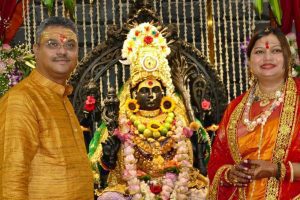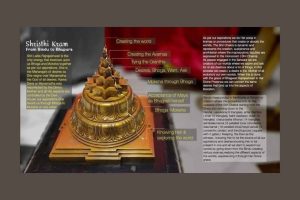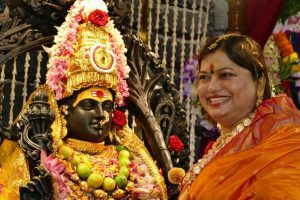Mumbai : In Hindu mysticism, Goddess Lalita Tripura Sundari stands as a symbol of divine beauty, power, and grace. She embodies both the material and spiritual realms, offering blessings that fulfil worldly desires Bhoga and grant spiritual liberation (Moksha). Shri Lalita Rajrajeshwari is the unique energy that bestows these dual blessings based on our aspirations.
 Goddess Lalita reigns as the Maharajani of desires, governing Manmatha, the God of all desires. Mythological stories tell us that Kama Deva or Manmatha was resurrected by the Divine Mother, and she controls all his aspects. This illustrates how desires, often seen as bindings, can become pathways to liberation when aligned with divine grace.
Goddess Lalita reigns as the Maharajani of desires, governing Manmatha, the God of all desires. Mythological stories tell us that Kama Deva or Manmatha was resurrected by the Divine Mother, and she controls all his aspects. This illustrates how desires, often seen as bindings, can become pathways to liberation when aligned with divine grace.
Devotees perform pooja and upasana (worship and meditative practices) according to their goals. She favours them through Bhoga leading to Moksha or vice versa. Central to this journey is the worship of the Shri Chakra, a geometric symbol representing the universe’s cycles of creation, sustenance, and annihilation. The Shri Chakra bridges the macrocosmic and microcosmic realms.
For those engaged in worldly life (Sansara), Lalita Tripura Sundari offers a path to align desires with spiritual growth. We create our worlds driven by aspirations, as desire is the mother of evolution. With the grace of Bhagwati Rajrajeshwari, these desires transform into tools for liberation. Her divine presence helps balance worldly pursuits with spiritual progress.


Through this sacred journey, devotees recognize the Devi as the source of all desires. By understanding her presence within and around us, we expand our inner worlds, realizing various aspects of existence. This experience, guided by her grace, reveals the transient nature of desires and the limits of material fulfilment.


Shri Lalita Rajrajeshwari VishwaMohini is the cosmic womb from which the universe emerges. She is the primordial throb (spandana) that creates all existence. To decode the universe’s subtleties, to know the macrocosm through the microcosm, to understand the Brahmanda through the Pindanda, and to realize the ultimate truth—one must seek VishwaMohini.
Through the divine interplay of desire and liberation, Goddess Lalita Tripura Sundari guides us to explore existence’s depths and achieve ultimate union with her eternal consciousness.
Stay blessed… Jai Gajanan….
(This article is written by guest author Dr. Swaroop Pramanik, BDS, Mumbai. He is a scholar in Hindu mysticism and is popularly referred as Bhau by his followers. He has etablished the Vishwamohini Devasthan at Goregaon west, Mumbai)


🙏🙏🙏jay maa lalita